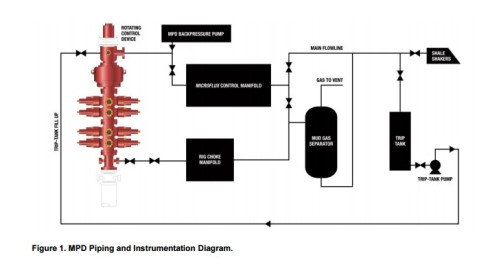Introduction:
Drilling operations exist in a world circumscribed by high and low pressures. The unexpected appearance of either can lead to delays, increased costs and even to failure. With increasing frequency, operators are arming themselves against the consequences of pressure-related surprises with techniques different from those used in the past. One such department from tradition is called Managed Pressure Drilling (MPD).
(Source: http://www.slb.com)

The International Association of Drilling Contractors (MMS 2008) defines MPD as an “adaptive drilling process used to precisely control the annular pressure profile throughout the wellbore.” The adaptiveness of MPD to various operational requirements is of critical importance to the success story of the technology up to date. According to Hannegan 2011, the timing could not be better for MPD due to the difficulty of reaching some of the world’s hydrocarbon resources and the need for efficient drilling operations at reduced costs.
(Source: https://www.onepetro.org/download/conference-paper/OMC-2015-318?id=conference-paper%2FOMC-2015-318)
VARIANTS OF MPD TECHNOLOGY
- RETURN FLOW CONTROL DRILLING (HSE):
This variant of MPD involves the use of the rotating control device (RCD) and the MPD choke manifold. The RCD has two rubber elements which provide a passive seal against the drill pipe and directs all the returns from the well to the automated MPD choke manifold where accurate flow parameters are recorded and trended. The RCD allows a closed – loop to be maintained during the drilling operation and unexpected influxes / losses are promptly detected and corrective action is applied before resuming normal drilling operations. The use of a closed loop system combined with right procedures ensures the risks to personnel, equipment and environment are properly mitigated.
- CONSTANT BOTTOMHOLE PRESSURE (CBHP):
This variant of MPD enables bottom-hole pressure to be maintained above formation pore pressure with the use of circulating frictional pressure and the application of surface back-pressure. Depending on operational requirements, SBP could also be applied during circulation to keep the BHP above the pore pressure. During pumps off events in a statically under-balanced condition, SBP is used to replace the lost AFP due to the stoppage of the mud pumps and no flow in the annulus. The ability to replace the lost AFP enables a constant BHP to be maintained during the drilling operation.
- PRESSURIZED MUD CAP DRILLING (PMCD):
This variant of MPD enables the drilling process to continue without incurring the large drilling mud costs (normally associated with losses). This technique mitigates extreme losses while drilling highly depleted zones containing large voids. This technique maintains a column of heavy fluid / mud on top of zones where severe losses occurs. The heavy fluid is pumped down the backside of the drill string and the level is maintained in the annulus. Sacrificial fluid for example, sea water is pumped down the string and into the large voids while drilling continues until the voids can be cased off.
- DUAL GRADIENT DRILLING (DGD):
This technique uses two different annulus fluid gradients in place. Lower density fluid can be injected through a parasite string or a concentric casing. The core objective is to achieve the desired bottom-hole pressure using a combination of two fluids with different densities.
MPD EQUIPMENT SET-UP
The integration of MPD equipment into existing rig layout is essential to the success of any MPD operation. As drilling rigs already have a layout for equipment and their operations and the personnel on these rigs are already familiar with the layout, it is important that any MPD equipment rigged up for specific purposes be integrated into the existing layout in such a way that it does not present a layer of confusion to the crew.

Figure 1 shows the equipment layout for the MPD project on which this paper is based. The RCD with an 18 ¾” 10K bottom flange was installed on the rig’s annular blowout preventer (BOP). See Piping and Instrumentation Diagram (P&ID) in the appendix section. The RCD body is the component which houses the bearing assembly and ensures that the bearing assembly is properly locked in place during operations. The bearing assembly allows rotation of the drill pipe and has two sealing elements installed on it which ensures a passive seal around the drill pipe. The Static Pressure Rating of the RCD is 2,000psi. The RCD/bearing assembly also ensures that the mud return from the well is directed to the MPD choke manifold thereby allowing accurate measurement of flow-out parameters and also enhances the safety of rig floor personnel.
Applications of MPD
- Kick Control
- Severe Drilling Fluid Loss- fractured or vugular formation
- Differential Sticking
- Tight pore pressure- fracture pressure “windows”
- Depleted Reservoir Drilling
- HPHT Drilling
- Unknown pore Pressure
- Wellbore Instability
- MBD + ERD (Extended Reach Wells)
- Low ROP
- Drilled Gas (Nuisance Gas)
- High H2S Levels
- Ballooning/ Breathing Formation
